
A comprehensive guide to lab safety, the Lab Safety Worksheet Answer Key PDF provides detailed solutions to exercises on safe practices, equipment, and hazard identification․
Designed for educational settings, it helps students and professionals master lab protocols, ensuring a safer environment for experiments and chemical handling․ Download for effective learning!
Overview of Lab Safety Fundamentals
Lab safety fundamentals are the cornerstone of a secure and efficient laboratory environment․ These principles emphasize the importance of proper practices to prevent accidents and ensure the well-being of everyone involved․ Key elements include the use of Personal Protective Equipment (PPE), safe handling of chemicals, and adherence to emergency protocols․ Understanding these basics is crucial for identifying hazards, such as spills, fires, or equipment malfunctions․ By mastering lab safety fundamentals, individuals can contribute to a culture of safety, minimizing risks and fostering a productive workspace․ These principles are essential for all lab participants, from students to professionals․
Importance of Lab Safety Worksheets
Lab safety worksheets are vital tools for reinforcing safe laboratory practices․ They provide structured exercises to test knowledge and identify gaps in understanding․ These worksheets cover critical areas such as PPE, chemical handling, and emergency procedures․ By completing them, students and professionals alike can assess their readiness to work safely in lab settings․ The answer key ensures accurate feedback, helping learners improve their skills․ Regular use of these resources fosters a culture of safety, reducing the risk of accidents and promoting compliance with lab regulations․ They are indispensable for educational and professional training programs focused on lab safety․
Structure of the Answer Key
The answer key is organized to align with the worksheet, providing clear solutions for each exercise․ It includes answers to multiple-choice questions, true/false statements, and fill-in-the-blank sections․ Detailed explanations for complex scenarios ensure understanding․ The key also addresses case studies, offering practical insights․ Designed for self-assessment, it helps users identify strengths and areas for improvement․ Regularly updated, it remains relevant to current lab safety standards, ensuring effective learning and adherence to safety protocols․
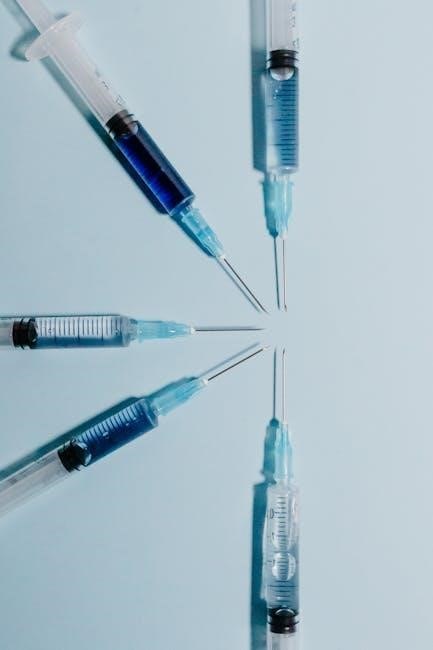
Personal Protective Equipment (PPE) in Lab Settings
PPE is vital for protecting against lab hazards․ Essential items include safety goggles, gloves, lab coats, and closed-toe shoes, ensuring safety during experiments and chemical handling․
Essential Items of PPE
The most critical PPE items in lab settings include safety goggles, which protect eyes from chemical splashes and spills․ Gloves are essential to prevent skin contact with hazardous substances․ A lab coat or apron acts as a barrier against spills and splatters․ Closed-toe shoes are mandatory to protect feet from dropped objects or chemicals․ Additional items like face shields or respirators may be required for specific tasks․ Properly wearing these items ensures a safer working environment and reduces the risk of accidents․ Always choose PPE based on the hazards present in the lab․
Proper Use and Maintenance of PPE
Properly using and maintaining PPE is vital for lab safety․ Always inspect PPE for damage before use and store it in a clean, dry place․ Safety goggles should be worn at all times when handling chemicals, and gloves must be disposed of after each use․ Lab coats should be tied securely and removed before leaving the lab․ Regularly clean and decontaminate reusable PPE, and replace items showing signs of wear; Following these practices ensures PPE effectiveness and compliance with lab safety protocols․ Proper maintenance extends the lifespan of PPE and protects against potential hazards․
Consequences of Improper PPE Usage
Improper use of PPE can lead to severe injuries, chemical exposure, and even fatalities․ Without proper protection, skin and eyes may be exposed to harmful substances․ Inhaling toxic fumes without a respirator can cause respiratory damage․ Loose clothing or long hair can catch fire near open flames․ Additionally, neglecting PPE protocols may result in legal consequences and lab privileges being revoked․ Accidents due to improper PPE usage are preventable, emphasizing the importance of adhering to safety guidelines․ Always ensure PPE is worn correctly to avoid these risks and maintain a safe working environment․
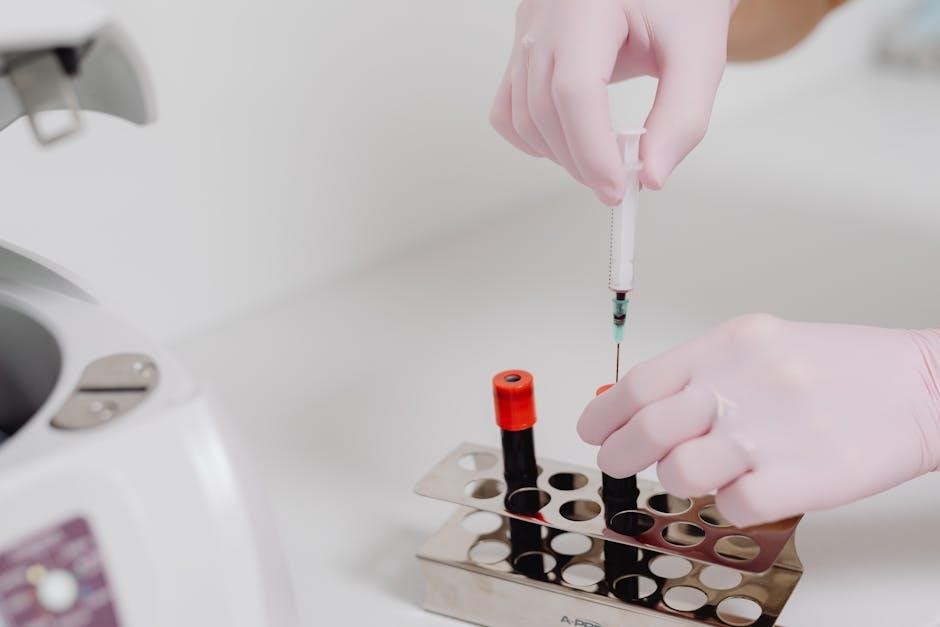
Common Lab Safety Hazards and Risks
Labs often face hazards like chemical spills, fire risks, and electrical hazards․ Proper training and precautions are essential to mitigate these dangers and ensure a safe working environment․
Chemical Hazards and Safe Handling
Chemicals in labs pose significant risks, including toxicity, flammability, and reactivity․ Proper handling requires understanding hazard labels, using personal protective equipment (PPE), and following safety protocols․ Corrosive and volatile substances demand extra caution․
Always read labels carefully, use gloves and goggles, and work in well-ventilated areas; Never mix chemicals without guidance, and store them in designated zones․ Spills should be contained immediately to prevent accidents․ Training and adherence to lab rules are crucial for safe chemical management․ Emergency procedures must be in place to address exposures or spills effectively, ensuring a protected environment for all lab personnel․
Fire Safety and Prevention Measures
Fire safety is critical in labs due to flammable chemicals and equipment․ Preventing fires involves storing combustible materials properly, avoiding open flames near hazardous substances, and keeping emergency exits clear․ Fire extinguishers should be easily accessible, with staff trained in their use․ Laboratories must have fire alarms and emergency plans in place․ In case of a fire, never use elevators and always follow evacuation routes․ Proper handling of electrical devices and hot surfaces is essential to minimize fire risks․ Regular drills ensure preparedness, while maintaining a clutter-free environment reduces ignition hazards, safeguarding everyone in the lab․
Electrical and Equipment-Related Hazards
Laboratories often contain electrical equipment that poses significant risks if mishandled․ Faulty wiring, overloaded circuits, and damaged cords can lead to shocks or fires․ Equipment should be regularly inspected for wear and tear․ Users must follow manufacturer guidelines and ensure devices are properly grounded․ Additionally, electrical appliances should never be used near water to prevent accidents․ Personnel should be trained in equipment operation and know how to respond to malfunctions․ Regular maintenance and adherence to safety protocols are crucial to mitigate these hazards and ensure a secure working environment in the lab․
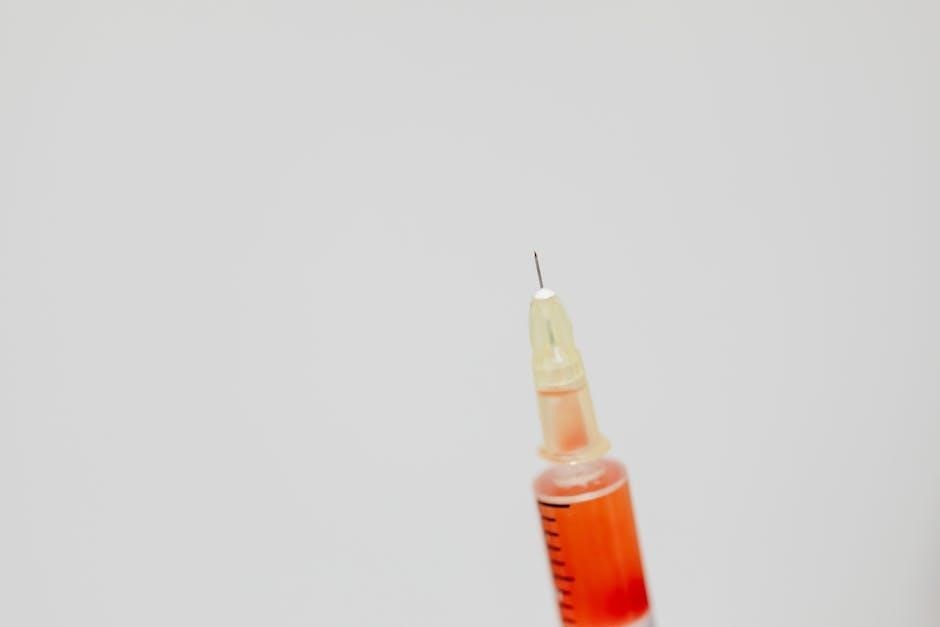
Safe Laboratory Practices
Essential practices include wearing PPE, reading instructions carefully, and using equipment properly․ Keep work areas clean, avoid eating/drinking, and follow protocols to minimize risks and ensure safety․
- Always wear appropriate PPE․
- Follow proper chemical handling procedures․
- Keep the lab clean and organized․
- Avoid distractions while conducting experiments․
Proper Lab Etiquette and Behavior
Proper lab etiquette ensures a safe and respectful environment․ Students should avoid eating, drinking, or chewing gum in the lab․ Long hair and loose clothing should be tied back, and open-toed shoes avoided․ PPE, like safety goggles, must be worn when handling chemicals or equipment․ Students should stay at their assigned benches, avoid horseplay, and follow instructions carefully․ No unauthorized experiments should be conducted․ Cleanliness is essential; dispose of waste properly and maintain a tidy workspace․ Respect shared equipment and report any damage or hazards to the instructor immediately․ Adhering to these behaviors minimizes risks and promotes a productive lab experience․
Handling and Storage of Chemicals
Proper handling and storage of chemicals are critical for lab safety․ Always wear gloves and goggles when handling chemicals to prevent skin and eye exposure․ Read labels carefully and follow instructions for use․ Store chemicals in their original containers, ensuring they are tightly sealed and labeled․ Keep chemicals in well-ventilated areas, away from incompatible substances, heat sources, and flammable materials․ Use secondary containers for transferring chemicals to prevent spills․ Dispose of chemical waste according to lab protocols, never down sinks or drains․ Regularly inspect chemical storage areas for leaks or damage․ Proper organization and labeling of chemicals ensure a safe and efficient lab environment for everyone․
Emergency Procedures and Protocols
In case of emergencies, knowing proper procedures is essential․ For fires, activate the nearest fire alarm, evacuate the area, and use a fire extinguisher if trained․ For chemical spills, contain the area, wear PPE, and neutralize if possible․ In case of skin or eye exposure, flush with water for 15 minutes․ For injuries, apply first aid and seek medical attention․ Know the location of emergency exits, eyewash stations, and fire extinguishers․ Regular drills ensure preparedness․ Always follow lab-specific protocols and notify supervisors of incidents․ Proper emergency responses minimize risks and ensure a safe environment for everyone․
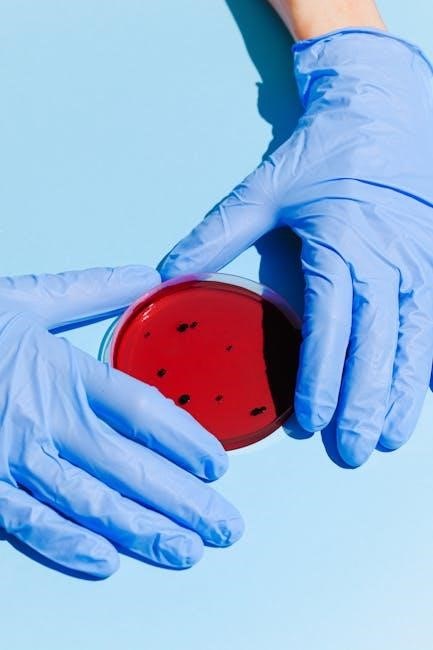
Lab Safety Scenarios and Case Studies
Scenarios and case studies illustrate real-life lab accidents, teaching how to identify and correct unsafe practices, ensuring better preparedness for potential hazards in laboratory settings․
Identifying Unsafe Practices in Illustrations
Illustrations in lab safety worksheets often depict hazardous scenarios, such as improper PPE use or incorrect equipment handling․ Users are tasked with identifying these unsafe practices, circling or labeling them, and explaining how to correct them․ For example, if a student is shown leaning over a lit burner without goggles, the correction would involve tying back hair and wearing safety goggles․ These exercises enhance observational skills and reinforce proper lab etiquette, ensuring students can recognize and address risks in real-life settings․ Detailed answer keys provide explanations, fostering a deeper understanding of safety protocols and their importance in preventing accidents․
Correcting Hazardous Situations
Correcting hazardous situations in lab settings requires immediate action to prevent accidents․ For instance, if a student is seen leaning over a lit burner without safety goggles, they should be instructed to step back, wear goggles, and maintain a safe distance․ Similarly, if chemicals are handled without gloves, students should be directed to wear appropriate PPE․ The answer key provides step-by-step solutions, emphasizing proper protocols for each scenario․ By addressing these errors, learners develop the ability to recognize and rectify dangerous practices, ensuring a safer lab environment․ This section reinforces the importance of adherence to safety guidelines in real-time situations․

Real-Life Examples of Lab Accidents
Real-life lab accidents highlight the importance of adhering to safety protocols․ For instance, a student handling chemicals without gloves suffered skin irritation due to improper PPE․ Another incident involved a fire caused by leaving a lit burner unattended․ These examples underscore the consequences of negligence․ The answer key provides detailed insights, helping learners understand how such accidents occur and how to prevent them․ By studying these cases, students develop a deeper appreciation for lab safety and the critical role of following established guidelines․ These real-world scenarios serve as powerful reminders of the potential risks in laboratory settings․
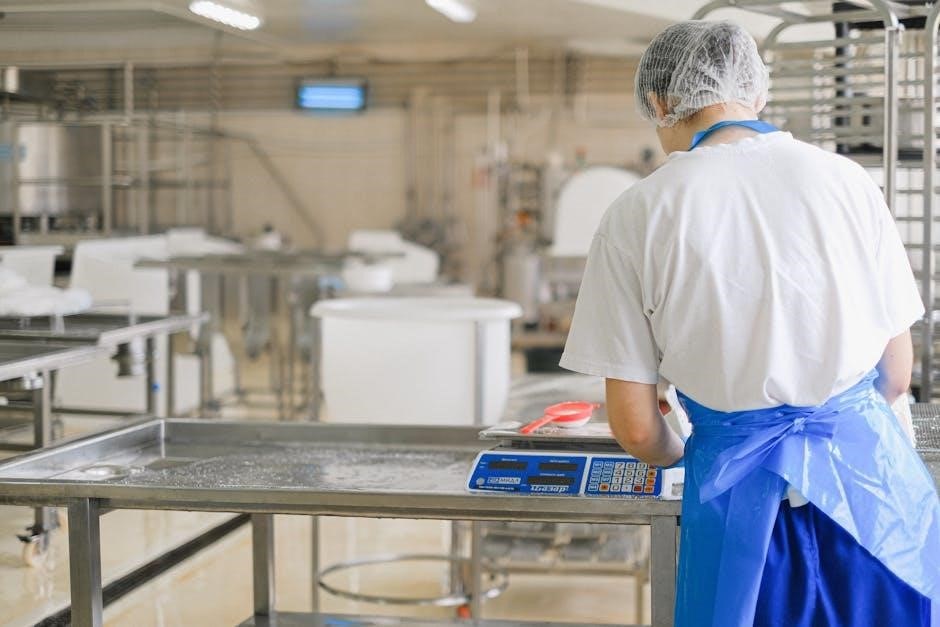
Lab Safety Quizzes and Assessments
Real-life lab accidents, such as chemical spills and equipment malfunctions, illustrate the importance of safety protocols․ For instance, a student handling corrosive chemicals without gloves suffered burns․ Another incident involved a fire caused by an unattended burner․ These examples emphasize the consequences of negligence and improper training․ The answer key provides insights into such cases, highlighting preventive measures and emergency responses․ By studying these scenarios, learners understand the risks and the necessity of adhering to lab safety guidelines to avoid similar incidents․ These real-world accidents serve as critical lessons in promoting a safer lab environment․
Multiple-Choice Questions on Lab Safety
Multiple-choice questions are a key component of lab safety assessments, testing knowledge on protocols, equipment, and hazard identification․ Questions cover topics like PPE, chemical handling, and emergency procedures․ For example, “What should you wear to protect your eyes in a lab?” with options like safety goggles, gloves, or a lab coat․ The answer key provides correct answers and explanations, helping learners understand mistakes․ These questions are designed to reinforce safe practices and ensure preparedness for real-life scenarios․ Regular quizzes enhance retention and compliance with lab safety standards, making them an essential tool for education and training․
True or False and Fill-in-the-Blank Exercises
True or False questions assess understanding of lab safety basics, such as “Safety goggles are required in the lab at all times․” Fill-in-the-blank exercises test specific knowledge, like naming PPE items․ These interactive tools engage students, ensuring they grasp key concepts․ The answer key provides correct responses, fostering self-assessment and learning․ Examples include identifying unsafe lab practices or explaining proper chemical storage․ These exercises are effective for reinforcing memory and preparing for practical scenarios, making them invaluable for educational and training purposes in maintaining a safe laboratory environment․
Answer Key for Self-Assessment
The Answer Key for Self-Assessment provides students with accurate answers to lab safety exercises, enabling them to evaluate their understanding․ It includes correct responses for true/false and fill-in-the-blank questions, along with explanations to clarify concepts․ This tool helps learners identify gaps in their knowledge and improve their grasp of safety protocols․ By reviewing the answer key, students can ensure they are well-prepared for lab environments and emergencies․ It is an essential resource for reinforcing learning and promoting confidence in applying lab safety principles effectively․
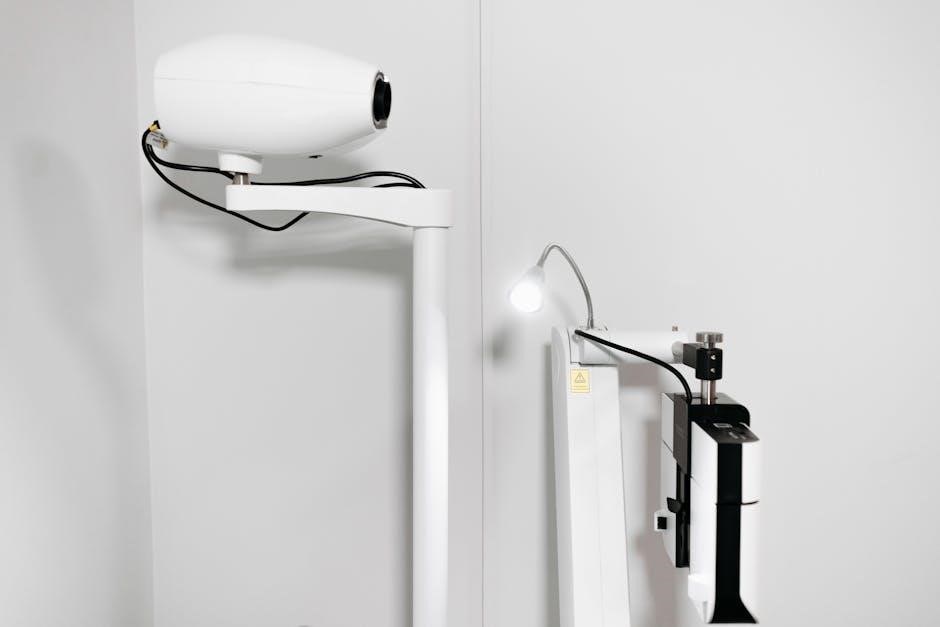
Lab Safety Symbols and Signage
Lab safety symbols and signage are crucial for alerting workers to potential hazards․ Common symbols include biohazard, flammable, and corrosive signs, guiding safe handling and emergency responses․
Understanding Safety Symbols
Understanding safety symbols is essential for identifying hazards in lab settings․ These symbols, often visual representations, convey critical information quickly․ Common examples include the biohazard symbol, indicating biological risks, and the flammability symbol, warning of fire hazards․ Pictograms are standardized to ensure clarity across languages and contexts․ They are integral to lab safety worksheets, helping users recognize and mitigate dangers․ Familiarity with these symbols enhances safety protocols and ensures compliance with regulations․ Regular training and reference materials, like the Lab Safety Worksheet Answer Key PDF, aid in mastery of these visual cues․ This knowledge is vital for preventing accidents and ensuring a secure environment․
Identifying Symbols on Lab Equipment
Lab equipment often features safety symbols to alert users of potential hazards and required precautions․ These symbols, such as biohazard or flammability markers, are standardized for clarity․ They guide users on safe handling, storage, and emergency procedures․ For instance, a biohazard symbol indicates contaminated materials, while a flammability symbol warns of fire risks․ The Lab Safety Worksheet Answer Key PDF includes exercises to identify and interpret these symbols, ensuring users understand their meanings and necessary actions․ Regular training and reference materials help reinforce this knowledge, critical for maintaining a safe laboratory environment and preventing accidents․ Always check equipment for symbols before use․
Importance of Signage in Labs
Clear and visible signage is essential in laboratory settings to communicate potential hazards and safety protocols․ Signs such as “Biohazard,” “Flammable Materials,” or “Authorized Personnel Only” provide immediate alerts, helping to prevent accidents․ Proper signage ensures compliance with safety regulations and standards, guiding lab users to handle equipment and chemicals safely․ The Lab Safety Worksheet Answer Key PDF emphasizes understanding these signs, as they are critical for maintaining a secure environment․ Ignoring or misinterpreting lab signage can lead to serious risks, making it a vital component of lab safety education and daily operations․
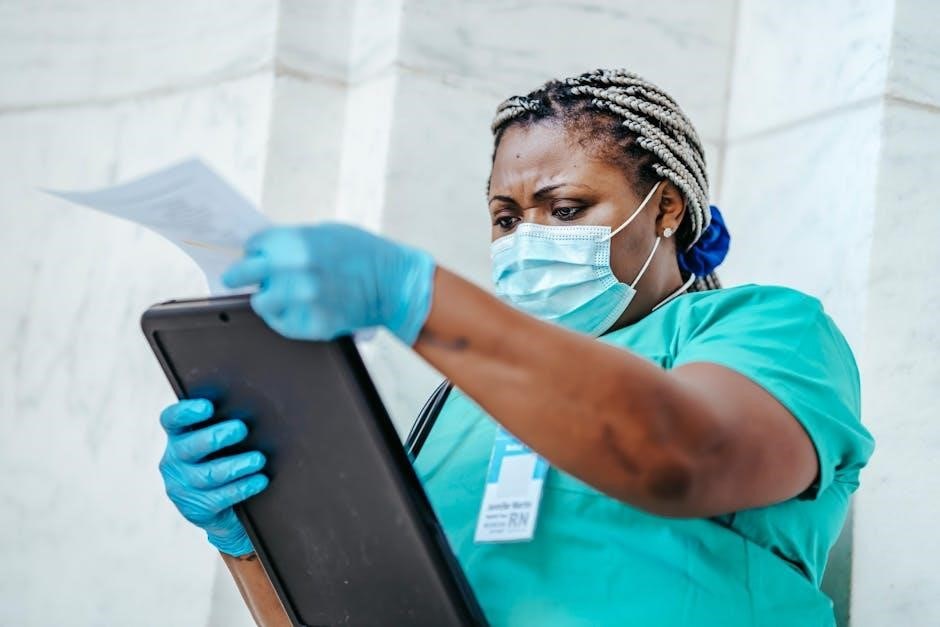
Lab Safety Rules and Regulations
Lab safety rules are essential for minimizing risks․ Avoid open-toed shoes, loose clothing, and prohibited items․ Consequences of violations include accidents or injuries․ Always follow established protocols, as outlined in the answer key․
General Lab Safety Rules
General lab safety rules are crucial to prevent accidents and ensure a safe working environment․ Key rules include avoiding open-toed shoes, loose clothing, and prohibited items like food or drinks․ Students must not enter labs without supervision and should remain at their designated workstations․ Proper hygiene practices, such as washing hands before and after experiments, are essential․ Work areas should be kept clean and tidy, with all chemicals stored correctly․ Never mix chemicals in sink drains, and dispose of waste properly․ Familiarize yourself with emergency exits and equipment, such as fire extinguishers․ Adhering to these guidelines promotes a safe and successful experimental experience․
Specific Rules for Different Lab Settings
Lab settings vary, requiring tailored safety rules to address unique hazards․ In high school labs, students must follow strict supervision and avoid unauthorized experiments․ University labs may involve more complex procedures, necessitating advanced safety measures and personal protective equipment․ Industrial labs require adherence to industry-specific regulations and regular safety audits․ Regardless of the setting, all labs must enforce proper chemical handling, storage, and disposal․ Signage and emergency preparedness are also critical․ These specific rules ensure safety and compliance across diverse laboratory environments, safeguarding personnel and facilities․ Understanding these guidelines is essential for all lab users, fostering a culture of safety and responsibility․
Consequences of Violating Lab Rules
Violating lab rules can lead to severe consequences, including accidents, injuries, and legal repercussions․ Neglecting safety protocols may result in chemical spills, fires, or exposure to hazardous materials․ In educational settings, students may face disciplinary actions, such as losing lab privileges or failing the course․ In professional environments, violations can lead to job termination, fines, or legal liability․ Additionally, improper practices can damage equipment, disrupt experiments, and pose risks to colleagues․ Adhering to lab rules is crucial for protecting individuals, ensuring experiment integrity, and maintaining a safe and responsible work environment․ Accountability is essential to prevent such outcomes and foster a culture of safety․
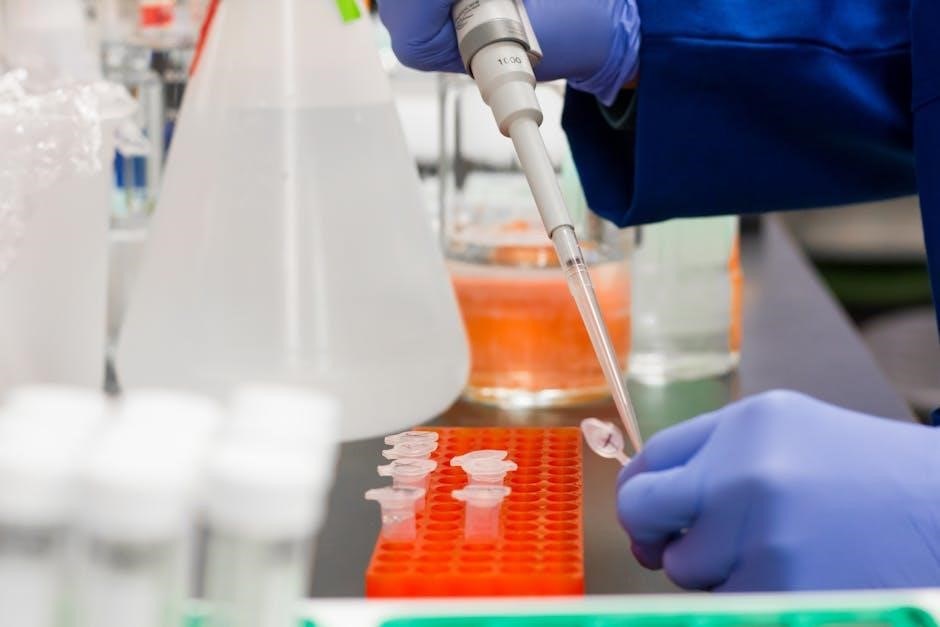
Lab Safety for Specific Audiences
Lab safety guidelines vary for different groups․ Middle school students focus on basic rules, while college and university students handle advanced procedures․ Professionals require specialized protocols and regulatory compliance․
Lab Safety for Middle School Students
Lab safety for middle school students focuses on introducing foundational rules and practices․ Key topics include proper use of PPE, such as goggles, and understanding basic safety symbols․ Students learn to identify hazards like open flames or chemicals․ Emphasis is placed on following teacher instructions and staying organized․ Worksheets and quizzes reinforce these concepts, ensuring a safe learning environment․ Supervision is crucial, with clear guidelines on handling materials and equipment responsibly․ The goal is to build good habits and awareness early, preparing students for more advanced lab work in the future while keeping them safe․ Regular reviews and assessments are essential․
Lab Safety for College and University Students
Lab safety for college and university students involves advanced protocols for handling hazardous materials and equipment․ Key focus areas include proper chemical handling, fire safety, and electrical equipment precautions․ Students learn to interpret safety data sheets (SDS) and use personal protective equipment (PPE) appropriately․ Emphasis is placed on adhering to standard operating procedures (SOPs) and understanding emergency response plans․ Worksheets and answer keys provide structured learning, ensuring students can identify and correct unsafe practices․ Practical exercises and scenario-based quizzes reinforce theoretical knowledge, preparing students for real-world lab environments and fostering a culture of safety and accountability in higher education settings․ Regular training and updates are essential․
Lab Safety for Professionals and Researchers
Lab safety for professionals and researchers emphasizes advanced protocols for complex experiments and specialized equipment․ Key areas include risk assessments, chemical handling, and compliance with regulatory standards․ Professionals must stay updated on the latest safety protocols and equipment․ The Lab Safety Worksheet Answer Key PDF serves as a valuable resource for reinforcing best practices and addressing specific hazards in research settings․ Regular safety audits, emergency preparedness, and collaborative training sessions are essential․ Continuous learning and adherence to safety guidelines ensure a protected environment for groundbreaking research and innovation, safeguarding both personnel and facilities from potential risks․ Professional accountability is paramount in maintaining high safety standards․
The Lab Safety Worksheet Answer Key PDF summarizes key safety principles, reinforcing proper lab practices and protocols․ It highlights the importance of vigilance and preparedness, ensuring a safer environment for all․ By mastering the content, individuals can confidently apply safety measures, reducing risks and fostering a culture of responsibility․ Continuous learning and adherence to guidelines are essential for maintaining a secure and efficient laboratory setting․
Key Takeaways from the Worksheet
The Lab Safety Worksheet Answer Key PDF emphasizes critical safety practices, such as proper PPE use, chemical handling, and emergency protocols․ It highlights the importance of understanding lab symbols, maintaining a clean workspace, and following specific rules to minimize risks․ Students learn to identify unsafe behaviors, correct hazardous situations, and apply safety measures consistently․ The worksheet also underscores the need for continuous learning and adherence to lab regulations․ By mastering these concepts, individuals can contribute to a safer, more efficient laboratory environment․ These key takeaways ensure preparedness and responsibility in handling lab-related tasks and emergencies effectively․
Encouraging Continuous Learning
Continuous learning is vital for maintaining lab safety standards․ The Lab Safety Worksheet Answer Key PDF encourages users to stay updated on new protocols, equipment, and hazards․ Regular reviews of safety materials and participation in training sessions help reinforce best practices․ Engaging in discussions and seeking feedback from instructors or peers fosters a deeper understanding of lab safety; By promoting a culture of lifelong learning, individuals can adapt to evolving laboratory environments and ensure their skills remain current․ This dedication to ongoing education is essential for preventing accidents and maintaining a safe workspace․
Final Tips for Safe Lab Practices
Adhering to lab safety requires consistent effort and awareness․ Always follow established protocols, use PPE, and ensure proper chemical handling․ Regularly inspect equipment and report any malfunctions․ Stay informed about safety symbols and emergency procedures․ Avoid distractions and maintain a clean workspace; By prioritizing safety, you protect yourself and others, ensuring a secure environment for experimentation and learning․ Remember, safety is everyone’s responsibility, and vigilance is key to preventing accidents․ These practices, guided by resources like the Lab Safety Worksheet Answer Key PDF, help create a culture of safety and accountability in every laboratory setting․



